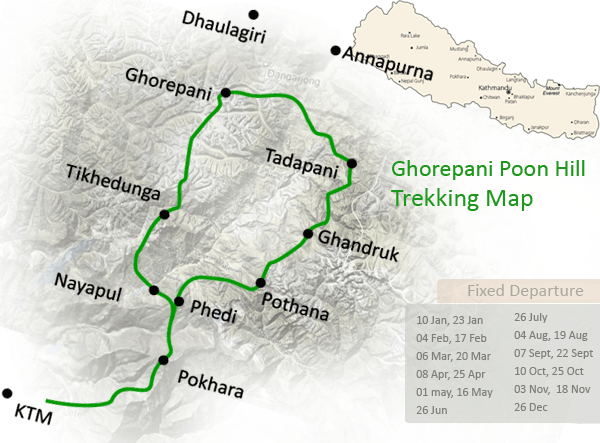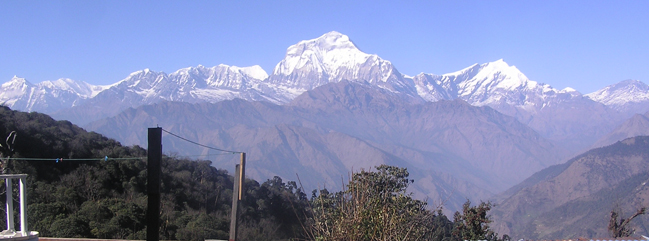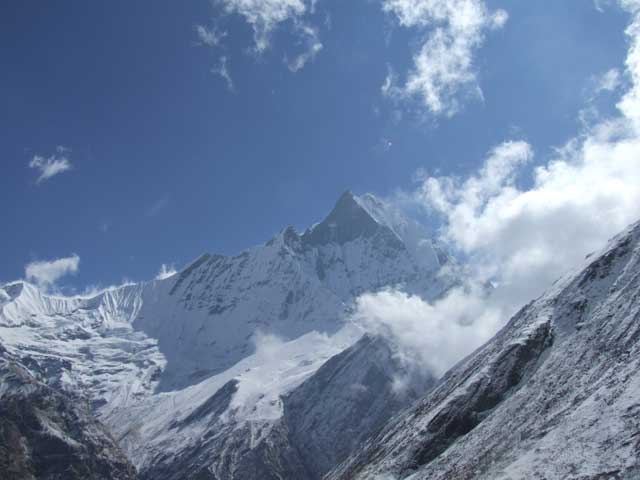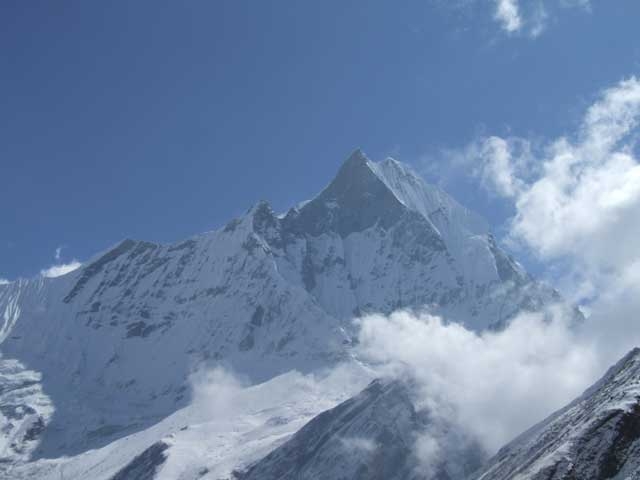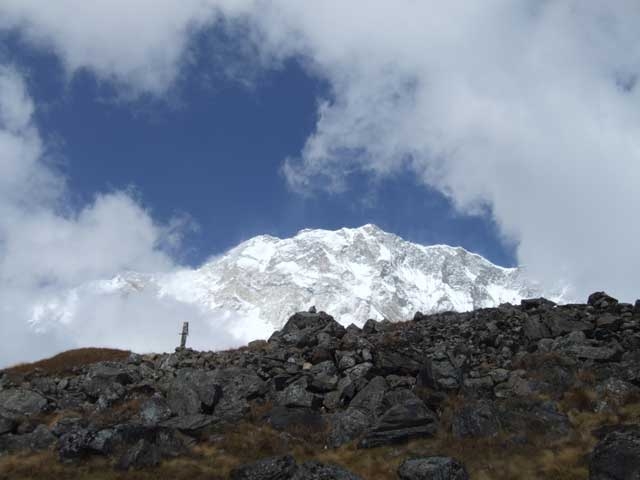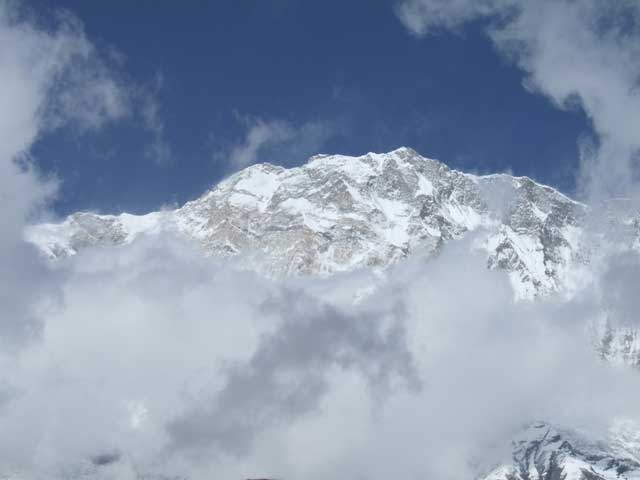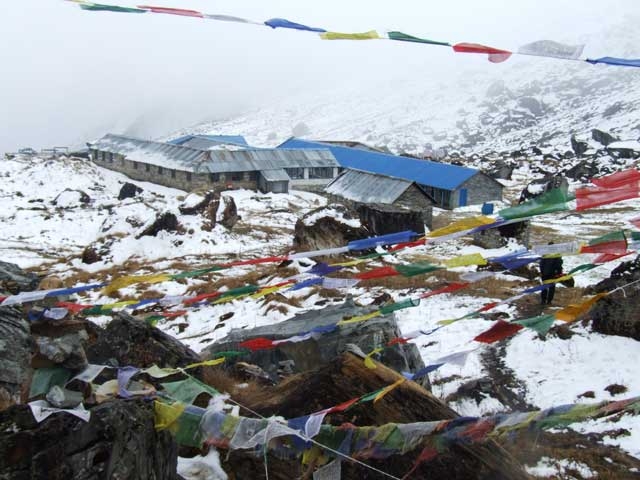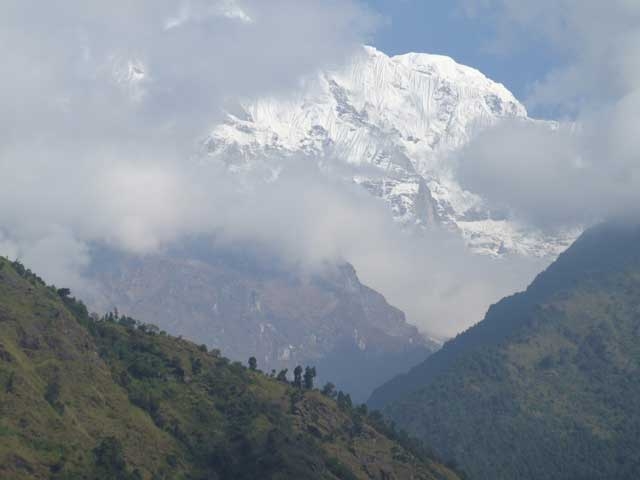The trek to Ghorepani – Poon Hill (Pun Hill) which is located in Annapurna region, is truly called as all the best of the trekking in Nepal.
The trek offers the spectacular mountain scenery along with charming villages inhabited particularly by the Gurungs & Magars, dense rhododendron forests full of birds and deep sub-tropical valleys, all set below the Annapurnas with the picturesque peak of Machhapuchhare (Fishtail Peak) dominating the skyline.
One of the important highlight of this trip is to make a climb on Poon Hill, possibly the most spectacular mountain scapes on Earth. When sun rises, it touches the snow-capped summits the Himalayan giants, Dhaulagiri (8,167m) and Annapurna (8,091m) along with a maze of other peaks, there gradually appear, just like magic that your eye could not believe.
Besides, during journey, you are rewarded by the natural beauties in your each & every footsteps.
The Ghorepani Poonhill Trek starts and ends in Pokhara, a colourful foray into the Annapurna region. The trail winds through patchwork valleys, dense mossy forests and past icy waterfalls where you can stop to cool your face. Around every corner is a tantalizing glimpse of the high mountains, whole horizons of which will be revealed to you as you reach the high points of your trek. Trekking in the Annapurna foothills to the view point at Poon Hill offering you unobstructed mountain views. As you ascend from Tikhedhunga to Ulleri, only the second day of your trek, the view of South Annapurna emerges. At Ghandruk, the mountains get much nearer; Annapurna South with Hiunchuli dominates the view here. Ghandruk is a large but beautiful village; the path ahead to Ghorepani via Tadapani is through dense temperate forests; it is a loverly walk with superb views of Annapurna South and Machhapuchhre from Bhaisi Kharka and Tadapani. A crest beyond Deurali, after Ghorepan, affords a stunning panorama of the Annapurnas and Dhaulagiri that equals the magnificient vista from Poon Hill. From the poon hill, 450 meter further up from Ghorepani, the vista extends from Dhaulagiri, tukuche and Nilgiri South to Annapurna I, Annapurna South, Hinuchuli and Machhapuchhre, Annapurna south really dominates the panorama. An easy trek in the spectacular mountain scenery through charming villages inhabited by the Gurungs, Magars dense rhododendron forests full of birds and deep sub-tropical valleys, all set below the Annapurnas with the picturesque Peak of Machhapuchhare (Fish Tail Peak) dominating the skyline. On the middle of the Ghorepani Poonhill trek you will get opportunity to immerse yourself in the holy water in Jhinu hot spring if you have one day extra to extend your trip.
Mosaic Adventure does not recommend Ghorepani Poonhill trek during the rainy season from July to mid September.
Day 01. Arrival at Kathmandu
Arrive at Kathmandu airport (1345meters). You will be met by our representative and transfer to hotel and a short brief about the trekking after refreshment.
Day 02. Sightseeing at Kathmandu
Kathmandu Valley Sightseeing Tour including Kathmandu Durbar Square, Patan Durbar Square, Monkey Temple, Pashupatinath Temple and Baudhanath Stupa.
Day 03. Kathmandu to Pokhara
Drive from Kathmandu to Pokhara (914m.) which takes about six hours. You depart for six hours drive to Pokhara (915m,), 200 kilometers west of Kathmandu. As you climb out of the Kathmandu valley, only to quickly descend again to the Trisuli River, you follow upstream to its junction with the Marsyangdi River. You follow the Marsyandi gently up through heavily terraced fields and small hill towns to the Seti River that takes you directly into Pokhara. Having pleasant weather, Pokhara is tourist’s paradise with full of natural as well as cultural heritage sites such as lakes, caves, temples of Buddhist and Hindus along with mountains. You can observe views to the north across the hills and Phewa Tal (lake) to the white peaks of the Annapurna and Dhaulagiri ranges. This drive will take most of the morning, leaving much of the afternoon to fall in love with its beauty. You can also fly from Kathmandu to Pokhara which takes about 25 minutes.
Day 04. Pokhara (915 m.) to Nayapul (1050m.)
Drive from Pokhara (915 m.) to Nayapul (1050m.) by car which takes one and half hours drive. Now, you begin your trek from Nayapul (1050m.) to Tikhedhunga (1577 m.) via Birethanti (1065m.) which takes about four and half hours. After breakfast at hotel you could drive by car for one and half hours to Nayapul. Then you start your trekking. The first part of your trek is easy passing through numerous small villages and settlements. Afterwards you could ascend gently to the final destination of the day. The majority people here are Gurung and their religion is Buddhist. They are engaged in agricultural activities, tourism business and some in Gorkha and Indian regiments.
Day 05. Tikhedhunga to Ghorepani (2675 m.)
Trek from Tikhedhunga to Ghorepani (2675 m.) which takes about six hours. The trail is steeply ascended for the early 2 hours and then ascends gently passing through Ulleri (2070m.) and Banthanti, Magar villages. On the way, you can enjoy good view of Machhapuchhre or Fish Tail (6997m.), Huinchuli (6441m.), and Annapurna (7219m.) south. Now your trail is quite easier passing through forest and descends gently up to the final camp. You could see some of the wild life such as monkey and various species of birds.
Day 06. Ghorepani to Poon Hill (3180m.)
Trek from Ghorepani to Poon Hill (3180m.) to Tadapani (2675m.) which takes about five and half hours. Early morning trip to Poon Hill (3232m.) to enjoy the sunrise view over Mt. Dhaulagiri (8167m.), Tukuche Peak (6920m.), Nilgiri (6940m.), Varaha Shikhar (7847m.), Mt. Annapurna I (8091m.), Annapurna South (7219m.), Annapurna III (7855m.), Machhapuchhre (6993m.), Annapurna IV (7525m.), Annapurna II (7937m.), Lamjung Himal (6931m.) and other numerous snowcapped mountain peaks. After breakfast trek Ghorepani to Tadapani (2650 m.) through the deep forests of rhododendrons, bamboos and oaks. En route, you frequently see waterfalls, rocks, wild animals, local birds and green scenarios. Tadapani is a small village surrounded by beautiful forests which grants you a magnificent view of Annapurna South, Hiunchuli, Fishtail, and Annapurna II and so on.
Day 07. Tadapani (2675m.) to Ghandruk (1950m.)
Trek from Tadapani (2675m.) to Ghandruk (1950m.) and it takes about three hours. It is very easy trek by descending gently all the way through rhododendron, oak and other kinds of dense forests. You could hear different kinds of birds chirping on the way. This is one of the popular destinations for the birds’ lovers. Ghandruk is a big Gurung village. There is a handicraft centre and Gurung museum. From this village you can see the views of Annapurna South, Hiunchuli, Gangapurna (7455m.), Annapurna III (7755m.) and Fishtail.
Day 08. Trek from Ghandruk to Nayapul (Pokhara):
It takes about five hours. It is very easy trek by descending gently half of the way through the rice field and local villages. From Ghandruk to until syaulibazar we normally descending then we walk flat part untill Nayapul then we drive from Nayapul to Pokhara. It takes around 1.13 Minutes.
Day 09. Pokhara to Kathmandu
Drive from Pokhara to Kathmandu by tourist mini bus that takes about seven hours. While driving from Pokhara to Kathmandu, you head up to Damauli,, Dumre, Muglin and Kurintar where the Nepal’s first Cable car is operated to reach to Manakamana Temple. En route, you could enjoy the mountain views, green sceneries, rice terrace fields, vegetable fields and people being engaged in their daily life activities. From Naubishe you climb up to Thankot, the gateway to capital city. You can also fly from Pokhara to Kathmandu which takes about 25 minutes.
Day 10. Final Departure
Transfer to international airport for your final flight departure.
NOTE: The above information is a guide and standard template of what we provide. The trek can be customized at your request to accommodate your specific requirements.
Note : On adventure trips of this type, weather, local politics, transport or a multitude of other factors beyond our control can result in a change of itinerary. It is, however, very unlikely that the itinerary would be substantially altered; if alterations are necessary the leader will decide what is the best alternative, taking into consideration the best interests of the whole group. Where a change does occur, we do everything we can to minimize its effect, but we cannot be responsible for the results of changes or delays.
Q.What type of shape do I need to be in, is this trip for me?
A. Trekking is suitable for average people who are moderately fit, thus no previous experience is required. Some physical fitness programs such as running, swimming, hiking is recommended before you embark on your journey. Persons suffering from a pre-existing medical condition or disease must seek medical advice before considering the trek. Whilst on the trek, it is common to experience some discomfort before being fully acclimatized.
To prepare for a strenuous trek you should begin training at least two to three months before your departure. As a guideline, an hour of aerobic exercise three to four times per week would be considered a minimum requirement. The best preparation is bushwalking involving relatively steep ascents and descents. If you can manage a couple of valley floor to ridgeline ascents per comfortable and able to enjoy the trek to the fullest. They are physically strong, sharp-witted and have an incredibly positive attitude towards a life that we would consider extremely tough. There is something about a trek in the Himalaya that draws you back time and time again. For keen walkers it is a paradise and even avowed non-walkers find that one foot just seems to follow the other, drawn by the appeal of what lies beyond.
Q. Will somebody come to pick me up at the Airport upon my arrival?
A. Yes, our Airport Representative will be there to greet you outside of Terminal Hall, he/she will be displaying an Kiwi Adventures Treks & Expedition sign board. Upon arrival, you will be transferred to your hotel.
Q. What sort of accommodation can I expect in Kathmandu and in trekking?
A. 11 night’s Trekking Guesthouse, 4 nights three/four star hotels in Kathmandu.
We use standard rooms from three/four star hotels in Kathmandu with breakfast included. Along the trekking routes teahouses/Lodges generally provide basic clean facilities with a mattress and a quilt or blanket. We can also offer you sleeping bags if needed (which need to return after the trip) but it is a good idea to always have your own sleeping equipment. We usually provide single and double rooms as well as the occasional dormitory. The dining room is downstairs around a fire. All food will be cooked to order in the little kitchen. You should not enter the kitchen unless asked to do so.
Q. What sort of food can I expect in trekking?
A. In trekking most teahouses (lodges) cook a delicious range of mostly vegetarian fare. Pasta, tuna bakes, noodles, potatoes, eggs, dhal bhat, bread, soups, fresh vegetables (variety depends on the season) and even some desserts like apple pies, pancakes, and some interesting attempts at custard. You will find a lot of garlic on the menu because it assists with acclimatization – eat some every day. In many larger villages you may find some meat on the menu. You can always get hot chocolate, tea, and hot lemon drinks, as well as soft drinks, and treats like chocolate and crisps.
Each day dinner and breakfast are used to take in the same lodge you spend the night. Lunch will be taken on the way to destination.
Q. What sort of transportation you use?
A. Kiwi Adventures Treks & Expedition is all about providing you with local insights as well as adventure, with that in mind, where we think you will get more out of your holiday by using different means of transport that is what we do. Using a variety of private transport is an integral part of our Himalaya tours and enhances the experience!
We use private tourist vehicles for sightseeing, city tours and pickups. Depending on the group size we use cars, minibus, van or land cruiser. These small light vehicles are more manoeuvrable and flexible enabling us to take you through the Narrow roads of Nepal. All the vehicles are usually air-conditioned unless we are travelling in cooler areas.
Q. What is the best season for this trekking?
A. Our trekking season extends from mid- September to May. From early September the monsoonal rains decrease. By end of September through to December the weather is usually stable with mild to warm days, cold nights. February, March, April, May, October, November, December are the best time to do trek.
Q. What is the weather & temperature like in trekking?
A. Weather in the mountains is notoriously difficult to predict. At night it is generally cooler the days are generally warm. Winter (January and February) will be bit colder but the days can be quite beautiful and warm if the sun is out. There will be bit of snow during the month of January, February and December. It is also important to make sure that you can stay warm and dry in just about any conditions. Expect the unexpected! The temperature could be as high as 20 deg C to -15 deg C low.
Q. Can I charge my digital camera or other batteries on my trip?
A. These facilities will be available in most of the places in your hotel reception by paying some service charges. Remember to bring your adapters!
Q. Is there any communication while we are on trekking?
A. There are telephones in some villages along the trekking routes from which you can make international calls.
Q. Can I use credit cards in the places visit in trekking?
A. In most cities yes, to some extent, however once you leave those cities behind, all you need is cash.
Q. How much additional money do I need per day?
A. In Kathmandu, you can allocate US$ 10 – 25 for a lunch / dinner. It’s all depends on your spending habits. US$7 to 10 US$ a day will be enough to buy bottles of water, chocolates and few drinks in trekking.
Q. Do I need to tip my guide and porters? How much would that be?
A. This is a difficult thing to gauge. We have seen everything from 20USD to 1000 USD per person for guides and porters. Tipping is not required, but a small way to show your guides and local porters thanks for their help. The level of the tip should reflect the level of personal involvement with your guide.
Q. Is the water OK to drink? Do I need to bring purifying tablets/filter?
A. In most places bottled water is readily available. If you wish to drink normal water, you need to use purifying aid, which you will need to bring with you.
Q. Are the Kiwi Adventures Treks & Expedition staff insured?
A. Our company insures all our trekking staff, including guide, cook, sherpa and porters.
Q. What essential documents do I need to bring with me on tour?
A. *Valid Passport – must be valid for up to 6 months after you return from your tour, keep a separate photocopy.
*Travel insurance, keep a separate photocopy
*Cash and Traveller’s Cheques, keep numbers and proof of purchase separate
*Flight tickets
*Emergency contact numbers for T/C’s, banks, insurance, family contacts.
Q. Can I add extra days to my trekking trip?
A. A hoilday should never be about making it to the final point quickly. Along your trek we can add days at your request with additional costs to cover guides, porters, accommodation and food.
Q. Do you use yaks/porters on the trek or do we carry all of our own gear?
A. Whilst on the trek, our porter will take care of your luggage. All you need to carry is your small day bag for your personal belongings like camera, water bottle, sun cream etc only.
Q. What opportunities will I have for shower along the trek?
A. In major places, we arrange guesthouse with hot shower. And in rest of the places, hotel water in bucket will be provided for shower; it would cost you extra about USD 3-4 per shower.
Q. Do you know about how many total miles the trek is?
A. Total distance of the entire trek is about 75 miles.
Cost Includes
• Airport / Hotel / Airport pick up & drop by private car / van / bus.
• Standard twin sharing accommodation in three/four star hotel in Kathmandu breakfast included.
• Standard twin sharing accommodation in two/three star hotel in Pokhara breakfast included.
• Sightseeing/Monument entrance fees in Kathmandu and Pokhara.
• Guided city tour in Kathmandu and Pokhara by private car / van / bus.
• All your standard Meals during the trek.
• Twin sharing Lodges, Guesthouses accommodation during the trek
• Local Ace the Himalaya licensed English speaking Guide.
• The required number of local staff and Porters to carry your luggage during the trek.
• Food, accommodation, salary, insurance, equipment and medicine for all staff.
• Annapurna conservation Park permits.
• Surface transfer from and to Kathmandu.
• All our government taxes.
• Official expense.
Cost Excludes
• Lunch and dinner whilst in Kathmandu and Pokhara .
• Your travel insurance (compulsory, please contact us if you wish to sign up for the Global Rescue membership plan).
• International airfare and airport departure tax.
• Nepal entry visa, you can obtain a visa easily upon your arrival at Tribhuwan International Airport in Kathmandu. (Tourist Visa with Multiple Entry for 30 days can be obtained by paying US $ 40 or equivalent foreign currency. Similarly, Tourist Visa with Multiple Entry for 90 days can be obtained by paying US $ 100. You will also require 2 passport size photos.)
• Alcoholic, hot and cold drinks.
• Personal trekking Equipment.
• Tips for trekking staff. (Tipping is expected).
• Any others expenses which are not mentioned on Price Includes section.
